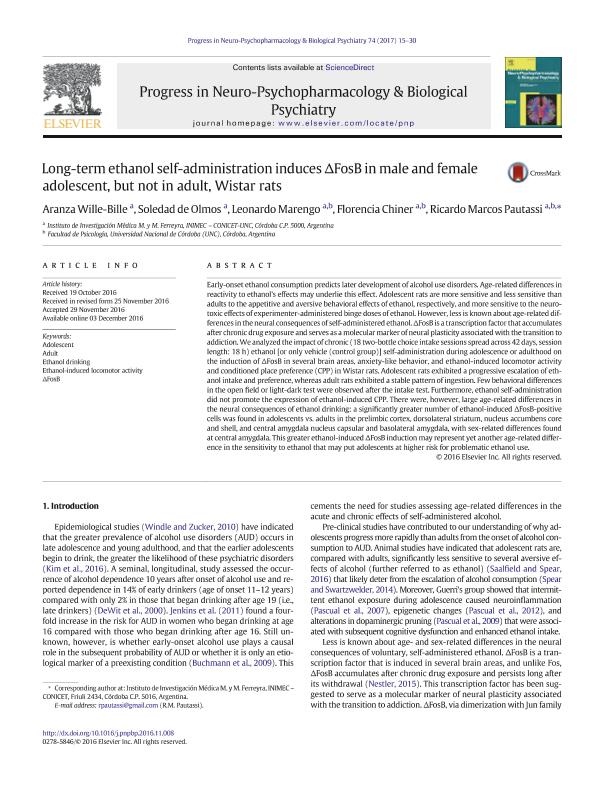Mostrar el registro sencillo del ítem
dc.contributor.author
Wille-bille, Aranza

dc.contributor.author
de Olmos, Soledad

dc.contributor.author
Marengo, Leonardo Gabriel

dc.contributor.author
Chiner, Florencia
dc.contributor.author
Pautassi, Ricardo Marcos

dc.date.available
2018-11-11T15:35:22Z
dc.date.issued
2017-03-06
dc.identifier.citation
Wille-bille, Aranza; de Olmos, Soledad; Marengo, Leonardo Gabriel; Chiner, Florencia; Pautassi, Ricardo Marcos; Long-term ethanol self-administration inducess ΔFosB in male and female adolescent, but not in adult, Wistar rats; Pergamon-Elsevier Science Ltd; Progress in Neuro-Psychopharmacology and Biological Psychiatry; 74; 6-3-2017; 15-30
dc.identifier.issn
0278-5846
dc.identifier.uri
http://hdl.handle.net/11336/64198
dc.description.abstract
Early-onset ethanol consumption predicts later development of alcohol use disorders. Age-related differences in reactivity to ethanol's effects may underlie this effect. Adolescent rats are more sensitive and less sensitive than adults to the appetitive and aversive behavioral effects of ethanol, respectively, and more sensitive to the neurotoxic effects of experimenter-administered binge doses of ethanol. However, less is known about age-related differences in the neural consequences of self-administered ethanol. ΔFosB is a transcription factor that accumulates after chronic drug exposure and serves as a molecular marker of neural plasticity associated with the transition to addiction. We analyzed the impact of chronic (18 two-bottle choice intake sessions spread across 42 days, session length: 18 h) ethanol [or only vehicle (control group)] self-administration during adolescence or adulthood on the induction of ΔFosB in several brain areas, anxiety-like behavior, and ethanol-induced locomotor activity and conditioned place preference (CPP) in Wistar rats. Adolescent rats exhibited a progressive escalation of ethanol intake and preference, whereas adult rats exhibited a stable pattern of ingestion. Few behavioral differences in the open field or light-dark test were observed after the intake test. Furthermore, ethanol self-administration did not promote the expression of ethanol-induced CPP. There were, however, large age-related differences in the neural consequences of ethanol drinking: a significantly greater number of ethanol-induced ΔFosB-positive cells was found in adolescents vs. adults in the prelimbic cortex, dorsolateral striatum, nucleus accumbens core and shell, and central amygdala nucleus capsular and basolateral amygdala, with sex-related differences found at central amygdala. This greater ethanol-induced ΔFosB induction may represent yet another age-related difference in the sensitivity to ethanol that may put adolescents at higher risk for problematic ethanol use.
dc.format
application/pdf
dc.language.iso
eng
dc.publisher
Pergamon-Elsevier Science Ltd

dc.rights
info:eu-repo/semantics/openAccess
dc.rights.uri
https://creativecommons.org/licenses/by-nc-sa/2.5/ar/
dc.subject
Adolescent
dc.subject
Adult
dc.subject
Ethanol Drinking
dc.subject
Ethanol-Induced Motor Activity
dc.subject
Delta Fosb
dc.subject.classification
Salud Ocupacional

dc.subject.classification
Ciencias de la Salud

dc.subject.classification
CIENCIAS MÉDICAS Y DE LA SALUD

dc.title
Long-term ethanol self-administration inducess ΔFosB in male and female adolescent, but not in adult, Wistar rats
dc.type
info:eu-repo/semantics/article
dc.type
info:ar-repo/semantics/artículo
dc.type
info:eu-repo/semantics/publishedVersion
dc.date.updated
2018-10-22T15:49:55Z
dc.journal.volume
74
dc.journal.pagination
15-30
dc.journal.pais
Estados Unidos

dc.journal.ciudad
Nueva York
dc.description.fil
Fil: Wille-bille, Aranza. Consejo Nacional de Investigaciones Científicas y Técnicas. Centro Científico Tecnológico Conicet - Córdoba. Instituto de Investigación Médica Mercedes y Martín Ferreyra. Universidad Nacional de Córdoba. Instituto de Investigación Médica Mercedes y Martín Ferreyra; Argentina
dc.description.fil
Fil: de Olmos, Soledad. Consejo Nacional de Investigaciones Científicas y Técnicas. Centro Científico Tecnológico Conicet - Córdoba. Instituto de Investigación Médica Mercedes y Martín Ferreyra. Universidad Nacional de Córdoba. Instituto de Investigación Médica Mercedes y Martín Ferreyra; Argentina
dc.description.fil
Fil: Marengo, Leonardo Gabriel. Consejo Nacional de Investigaciones Científicas y Técnicas. Centro Científico Tecnológico Conicet - Córdoba. Instituto de Investigación Médica Mercedes y Martín Ferreyra. Universidad Nacional de Córdoba. Instituto de Investigación Médica Mercedes y Martín Ferreyra; Argentina. Universidad Nacional de Córdoba. Facultad de Psicología. Centro de Investigaciones de la Facultad de Psicología; Argentina
dc.description.fil
Fil: Chiner, Florencia. Consejo Nacional de Investigaciones Científicas y Técnicas. Centro Científico Tecnológico Conicet - Córdoba. Instituto de Investigación Médica Mercedes y Martín Ferreyra. Universidad Nacional de Córdoba. Instituto de Investigación Médica Mercedes y Martín Ferreyra; Argentina. Universidad Nacional de Córdoba. Facultad de Psicología. Centro de Investigaciones de la Facultad de Psicología; Argentina
dc.description.fil
Fil: Pautassi, Ricardo Marcos. Consejo Nacional de Investigaciones Científicas y Técnicas. Centro Científico Tecnológico Conicet - Córdoba. Instituto de Investigación Médica Mercedes y Martín Ferreyra. Universidad Nacional de Córdoba. Instituto de Investigación Médica Mercedes y Martín Ferreyra; Argentina. Universidad Nacional de Córdoba. Facultad de Psicología. Centro de Investigaciones de la Facultad de Psicología; Argentina
dc.journal.title
Progress in Neuro-Psychopharmacology and Biological Psychiatry
dc.relation.alternativeid
info:eu-repo/semantics/altIdentifier/doi/https://doi.org/10.1016/j.pnpbp.2016.11.008
dc.relation.alternativeid
info:eu-repo/semantics/altIdentifier/url/https://www.sciencedirect.com/science/article/pii/S0278584616303098?via%3Dihub03098?via%3Dihub
Archivos asociados
